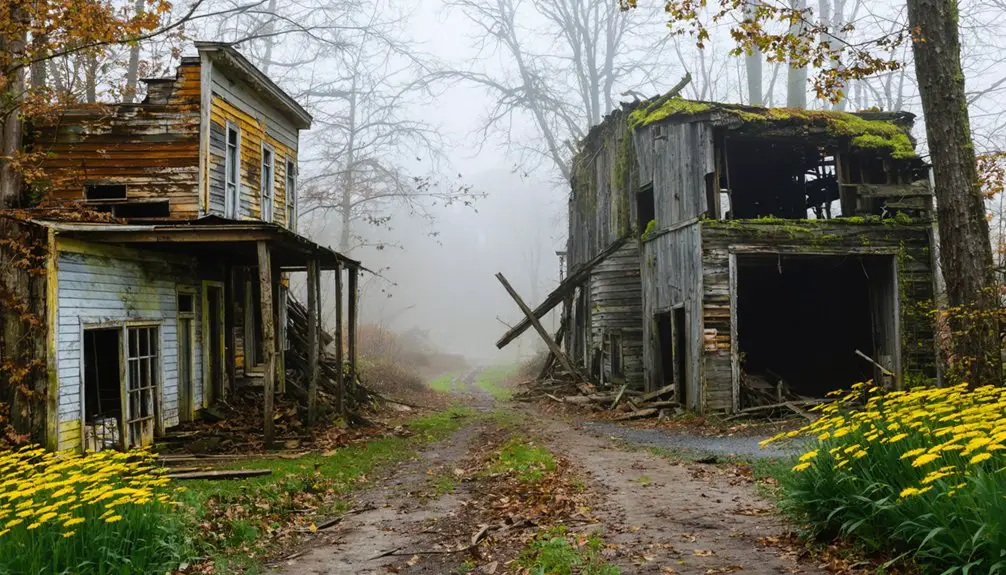You’ll discover Fairfax as an abandoned coal mining town in Pierce County, Washington, where peak operations once produced 250,000 tons monthly during the early 1900s. The thriving community of 500 residents enjoyed amenities like a school, swimming pool, and social gatherings at the Old Town Hall until 1941. Today, you can explore the 640-acre historic site’s remaining coke ovens, building pillars, and railroad remnants, each telling tales of this industrial frontier’s rise and fall.
Key Takeaways
- Fairfax was a thriving coal mining town established in 1896 that became a ghost town by 1941 after mines closed.
- At its peak in 1915, Fairfax had 500 residents, company-owned houses, a school, swimming pool, and post office.
- The town’s decline began in the 1930s when coal demand decreased as oil and gasoline became preferred energy sources.
- Natural disasters, including floods that destroyed vital infrastructure, accelerated the town’s abandonment and deterioration.
- Today, visitors can explore 640 acres of historic ruins, including mine pillars, coke ovens, and railroad remnants south of Fairfax Bridge.
The Rise of a Coal Mining Frontier
While coal discoveries dotted Washington State’s landscape since the 1830s, Fairfax’s mining story began in 1896 when the Western American Company established its namesake mine in Section 26.
Like many entries found in disambiguation pages, the name Fairfax carried different meanings across various locations in America.
You’ll find that W.A. McNeil, who named the town after his Iowa hometown, was among the savvy investors who recognized the region’s potential after coal’s initial discovery near Wilkeson in 1862.
The town’s coal mining operations quickly gained momentum. By 1902, you’d have seen 35 coke ovens transforming raw coal into valuable fuel, placing Fairfax at the forefront of Pierce County’s industrial advancement. The mine’s success was evident as they produced 250,000 tons monthly during peak operations in the early 1900s.
The operation’s success became evident in 1906 when production reached 21,858 tons annually. This industrial boom sparked rapid community growth, attracting workers with competitive daily wages between $2.25 and $4.
Life in an Industrial Company Town
You’d find life in Fairfax shaped by the rhythms of industrial labor, with miners earning specialized wages as electricians and coal diggers while lumber workers commanded $2.25-$4.00 per day at the Manley-Moore mill.
Living in company-owned houses, you’d experience the town’s unique blend of isolation and community, complete with amenities like a school swimming pool, post office, and cultural activities at the Old Town Hall. The town’s coal production soared, with coking ovens producing over 250,000 tons monthly during the early 1900s. Much like the Union occupation in 1862, the industrial companies maintained strict control over the area.
Your daily routines would revolve around the Western American Company and Manley-Moore Lumber Company’s oversight, as these enterprises controlled everything from housing assignments to utility services, while still allowing space for social outlets like the town baseball team and brass band.
Working Life and Labor
As coal and timber dominated Fairfax’s industrial landscape in the early 1900s, workers found themselves enmeshed in a classic company town structure where their entire lives revolved around their employers.
You’d find diverse labor roles throughout the operations, from specialized electricians at the mine to skilled millwrights earning $3.50-$4 daily at the lumber mill. Common laborers earned $2.25-$2.50 per day. Similar to how high-tech businesses would later transform Fairfax County’s economy, these industrial operations shaped the region’s development.
Working conditions reflected the era’s industrial demands. You’d spend your days amid the heat of coking ovens, the depths of coal extraction pits, or the bustle of lumber production.
The mine operated at high capacity for nine months, with reduced output during slower periods. Until 1921, you’d rely solely on rail or horse transport to reach your workplace, as no roads connected to the isolated town.
Social Dynamics and Diversity
During its peak in the early 1900s, Fairfax’s social fabric reflected the classic industrial company town, with roughly 500 residents living under the watchful eye of the Western American Company and later the Manley-Moore Lumber Company.
You’d find a mix of permanent families and transient workers, creating distinct social hierarchies based on employment status and length of residency. Community interactions centered around shared industrial work, with both coal miners and lumber workers living near their respective worksites.
The town’s layout fostered close-knit relationships, while company-provided amenities like the school and swimming pool served as social hubs. Cultural expressions remained largely tied to work-related gatherings and family life.
Though records don’t specify ethnic makeup, you’d likely have encountered immigrant laborers common to early 1900s industrial towns, especially among specialized workers like electricians.
Company Control and Amenities
The Western American Company and Manley-Moore Lumber Company shaped every aspect of life in Fairfax through their tight industrial control.
You’d find your housing assigned by the companies, with basic accommodations provided for workers and their families. Your daily wages would range from $2.25 to $4.00, depending on your role as a miner, millwright, or general laborer.
Despite the companies’ firm grip, you’d have access to some community amenities. There was a school with a swimming pool, a post office that operated until 1943, and essential industrial facilities like the 35 coke ovens installed in 1902.
Until 1921, you couldn’t even reach town by road – only rail or horse would get you there, underlining the companies’ power over your mobility and daily existence.
Mining Operations and Coal Production
You’ll find Fairfax’s coal extraction operations were extensive, with the Western American Company’s mine on Section 26 producing 21,858 tons in 1906 alone.
In its peak years of 1909-1910, the mine required skilled workers including electricians and millwrights who earned between $2.25 and $4.00 per day. The town had historical significance as it was named after McNeil’s hometown in Iowa.
The mine’s operations were supported by 35 to 60 coke ovens that processed coal into valuable metallurgical coke for steelmaking, establishing Fairfax as a significant producer in Pierce County’s coke industry.
Coal Extraction Methods
Mining operations at Fairfax relied primarily on the chute-and-pillar method, where miners strategically cut coal while leaving supporting pillars to prevent mine roof collapse. You’d find miners using high explosives to break coal free from the seams, making extraction more efficient in these carefully engineered tunnels.
The most distinctive feature was their innovative coal flume system – an elevated wooden chute stretching 1.5 miles, standing 20 feet above ground.
At 8 feet wide and 4 feet deep, this water-powered transport system whisked coal directly to the bunkers at Fairfax. Workers could access a 2-foot maintenance walkway atop the flume, ensuring smooth operation of this critical infrastructure that transformed how you’d move coal from mine to market. After 1911, the town became renowned for producing high-quality furnace coal that fueled industrial growth in the region.
Peak Production Years
During Fairfax’s boom years, coal production surged from its 1896 beginnings under Western American Company to reach impressive heights by the early 1900s. You’d have seen the first coal shipments leave town in 1899, with production skyrocketing to nearly 22,000 tons by 1906.
The mine’s success sparked regular community gatherings as workers from diverse backgrounds, including Black and Japanese laborers, filled the growing workforce.
The economic impact rippled through the region, with up to 60 coke ovens operating by 1902. You’d have found a bustling infrastructure supporting this boom: a specialized railroad spur, a massive coal flume, and a locomotive turntable.
Daily wages ranging from $2.25 to $4 attracted skilled workers, from electricians to millwrights, fueling the town’s prosperity.
Social Dynamics and Cultural Diversity
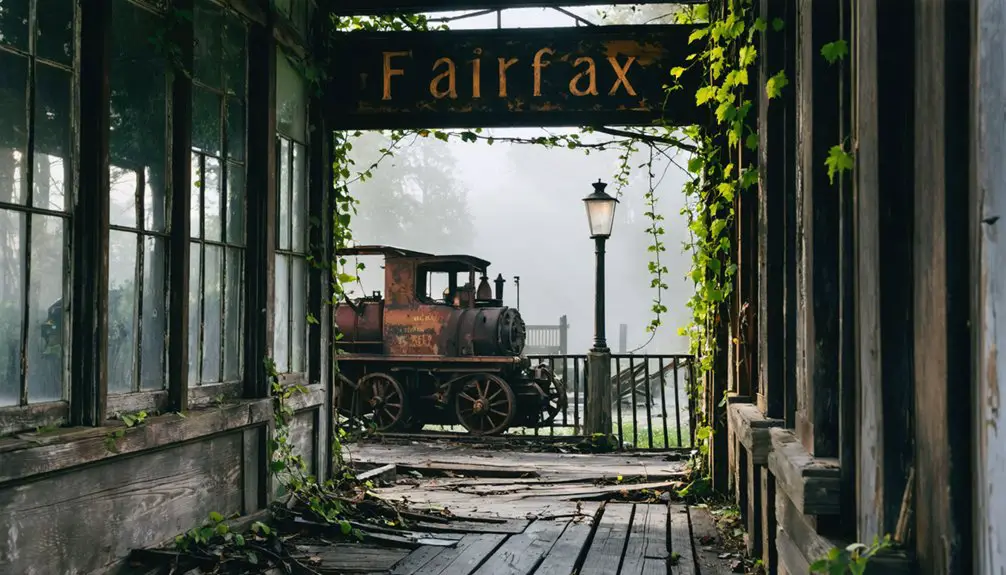
While Fairfax thrived as a company-owned mining and lumber town, its social fabric was tightly woven through the paternalistic governance of the company that controlled nearly every aspect of daily life.
You’d find about 500 residents at its peak in 1915, living in company-provided housing and sharing communal amenities like the school and swimming pool.
Community interactions were shaped by the town’s isolation, as you could only reach Fairfax by train or horse until 1921.
Life in early Fairfax flowed at its own pace, cut off from the outside world except for train tracks and horse trails.
The population included diverse immigrant coal miners and lumber workers, though records of ethnic integration remain limited. Archaeological evidence has uncovered items of Japanese manufacture, suggesting a significant presence of Japanese workers and their families in the community.
You’d see tight-knit family networks living in multi-generational households, with social life revolving around company-sponsored events and informal gatherings. Burlington Northern demolished the remaining residential structures in the 1980s.
Women’s roles were primarily domestic, while men worked in industrial jobs.
Transportation and Infrastructure Development
As the Northern Pacific Railway extended its spur line from Carbonado to Fairfax in 1897, you’d find the town’s lifeline established through an essential rail connection that would serve as its only reliable access until 1921.
The transportation evolution reflected Fairfax’s industrial ambitions, with a sophisticated network of coal-handling facilities including a 1.5-mile wooden flume that moved coal using water pressure. The Eatonville Lumber Company dominated the local landscape with its extensive rail operations.
You’d witness sixty coke ovens operating by 1902, supported by rail sidings and specialized infrastructure for processing over 250,000 tons of coal monthly.
Infrastructure challenges plagued the town’s development. While Pierce County’s 1921 road brought limited vehicular access, the route battled boggy terrain and fallen trees.
Natural disasters, particularly floods that destroyed the Carbon River railroad bridge, ultimately hastened Fairfax’s decline by severing vital transport links.
Peak Years and Economic Success
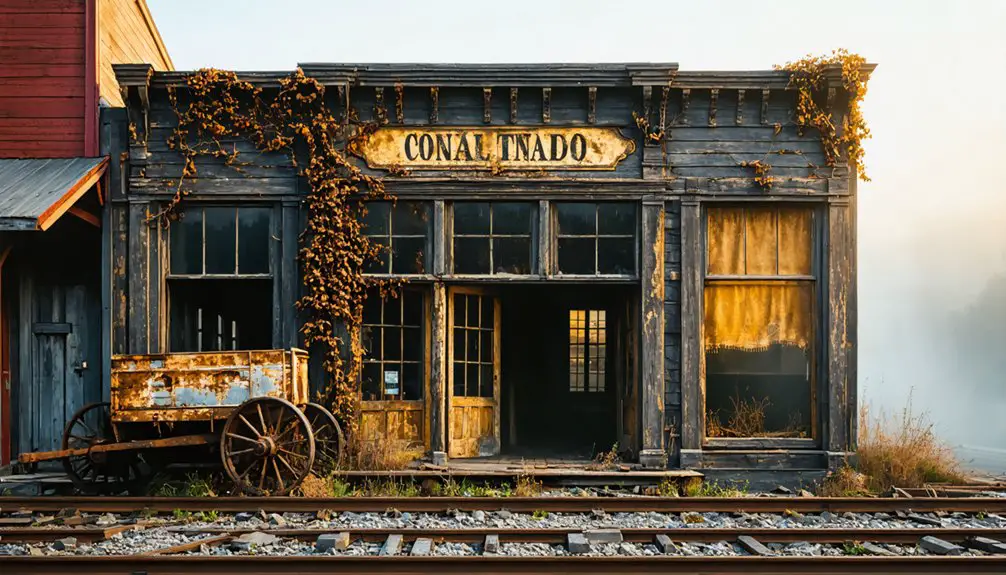
The early 1900s marked Fairfax’s transformation into a thriving coal empire, with monthly production exceeding 250,000 tons from its bustling mines and sixty coke ovens.
You’d find a robust industrial legacy throughout the town, from the extensive cut-and-pillar mining operations to the 1.5-mile wooden flume carrying coal to waiting bunkers.
The town’s community resilience shone through its rapid development of essential amenities. You could’ve visited the prominent Fairfax Hotel, cooled off at the local swimming pool, or sent your children to the town school.
Despite earlier labor tensions in the 1890s, the diverse workforce of white, Black, and Japanese miners sustained the booming economy. The coking industry’s success fueled unprecedented growth, making Fairfax a model of early 20th-century industrial prosperity.
The Decline and Abandonment Era
Fairfax’s prosperous era came to an abrupt halt when America’s shift toward oil and gasoline energy sources decimated coal demand in the 1930s. The economic factors proved catastrophic – coal yields plummeted over two decades, triggering widespread mine closures and job losses throughout the region.
You’d have witnessed a rapid community exodus as families abandoned their homes in search of work elsewhere. By 1941, Fairfax had become a ghost town.
The Carbon River’s floods washed away the railroad bridge, while fires claimed the town’s hotel and school. Pierce County foreclosed on numerous properties due to unpaid taxes, and the surrounding forest gradually reclaimed the townsite.
The town’s isolation in the Carbon River Canyon, coupled with its inability to diversify beyond coal, sealed its fate.
Natural Forces and Structural Loss
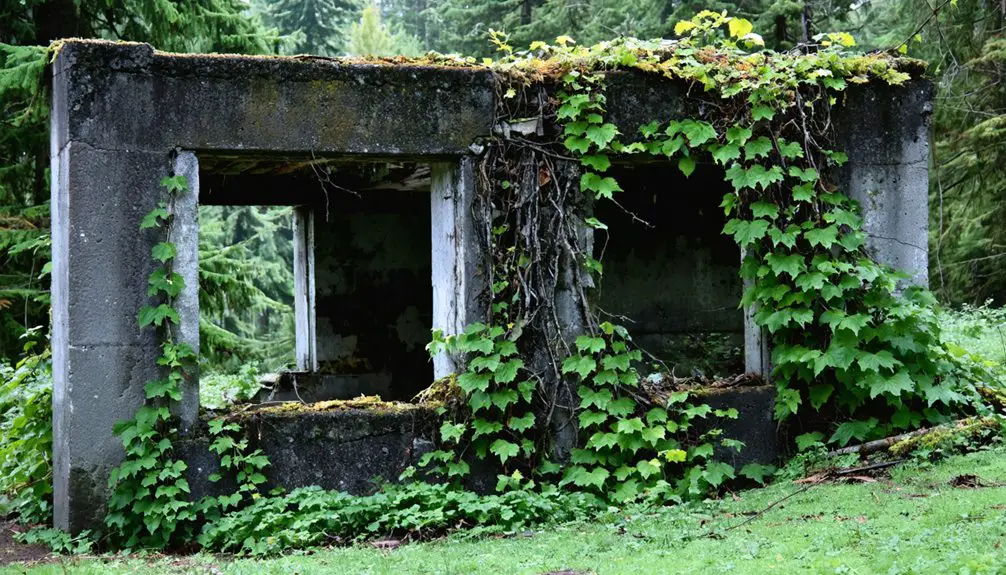
You’ll find the destruction of Fairfax’s infrastructure began with the Carbon River’s fierce floods, which washed away the critical railroad bridge connecting the town to wider civilization.
Fire then ravaged key community landmarks, including the prominent Fairfax Hotel and the town school, leaving only charred remnants behind.
These devastating natural forces, combined with seasonal flooding that repeatedly damaged access roads and trails, accelerated the physical dismantling of this once-thriving mining community.
Floods Destroy Key Infrastructure
While coal mining sustained Fairfax’s economy through the early 1900s, devastating floods along the Carbon River ultimately hastened the town’s demise.
You’ll find that flood impacts hit hardest when raging waters destroyed the critical railroad bridge, severing the town’s essential coal transport lifeline. The infrastructure challenges proved insurmountable as seasonal rains transformed access roads into boggy, impassable routes.
Located on a vulnerable floodplain beside the Carbon River, Fairfax’s structures stood little chance against the relentless waters.
The floods ravaged transportation networks and mining facilities, making rebuilding economically unfeasible as coal demand declined.
Today, you’ll see only scattered foundations and pillars – silent witnesses to the destructive power of the river that once sealed this mining town’s fate.
Fire Claims Historic Buildings
Two devastating fires claimed the historic Fairfax Hotel and town school, marking a critical turning point in the ghost town’s structural decline.
You’ll find that these fires, occurring after the town’s 1941 abandonment, dealt a severe blow to historic preservation efforts and community memory. The blazes, combined with aggressive forest reclamation and flooding from the Carbon River, accelerated the destruction of Fairfax’s built heritage.
Without fire suppression in the deserted town, wooden structures burned unchecked.
Today, you can only discover foundations, small pillars, and the old pool’s concrete remnants – silent witnesses to the town’s former liveliness. The loss of these landmark buildings, particularly the hotel and school that once served as essential social hubs, has made it challenging to visualize Fairfax’s coal mining heyday.
Preserved Ruins and Archaeological Findings
Archaeological investigations at the Fairfax townsite have yielded significant material evidence of its coal mining past, with over 1,300 artifacts recovered from systematic excavations.
Through careful artifact analysis and archaeological preservation efforts, you’ll discover the fascinating social dynamics of this company-owned coal mining town that operated from the 1890s to 1941.
Key findings reveal:
- A concentrated cluster of early 19th-century artifacts spanning 20 by 15 feet, likely from tenant housing
- Structural remains that show clear divisions between laborers’ and managers’ living quarters
- Evidence of prehistoric Native American activity, though limited to 20 pieces of scattered chipping debris
The site’s rich layering of artifacts tells the story of multiple occupations, from indigenous peoples through the industrial boom years, offering glimpses into the daily lives of those who called Fairfax home.
Exploring the Historic Site Today
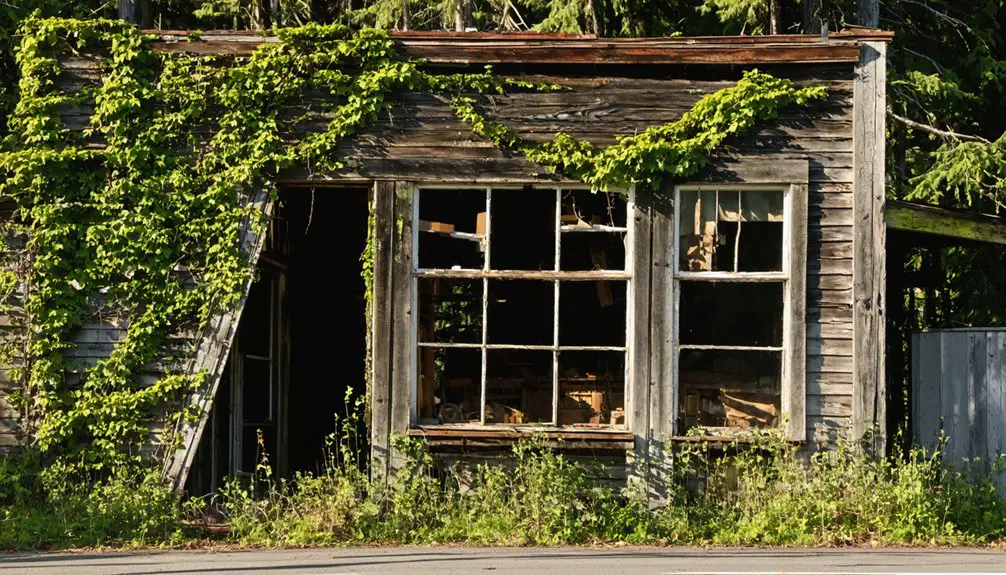
Today, visitors seeking to explore the remnants of Fairfax Ghost Town must trek along a decommissioned road south of Fairfax Bridge, traversing through untamed terrain that nature has steadily reclaimed.
Your ghost town exploration requires sturdy boots and careful navigation through boggy spots, downed trees, and uneven ground.
Navigating abandoned settlements demands proper footwear and vigilant attention to hazardous terrain and natural obstacles along the path.
You’ll descend toward the Carbon River before entering an open meadow where the townsite once thrived. While most structures have succumbed to floods, fires, and salvaging, you can still discover mine building pillars, coke ovens, and the railroad turntable post.
Of particular historical significance is the old school’s swimming pool location and scattered building foundations.
The 640-acre site, designated as open space in 2002, offers self-guided adventure through this fascinating piece of coal mining history.
Frequently Asked Questions
Are There Any Ghost Stories or Paranormal Activities Reported at Fairfax?
You won’t find documented ghost sightings or haunted history here – though visitors describe the ruins as spooky. The eerie atmosphere comes from natural decay rather than confirmed paranormal activity.
What Happened to the Mining Equipment After the Town Was Abandoned?
You’ll find most mining equipment was dismantled or removed after 1941, with no historical preservation efforts. Natural decay, floods, and Burlington Northern’s 1991 demolition eliminated nearly all remaining industrial artifacts.
Can Visitors Take Artifacts Found at the Fairfax Site?
No, you can’t take artifacts – it’s illegal. Visitor regulations protect the site’s historical value through artifact preservation. You’re welcome to explore and photograph, but must leave everything where you find it.
Is Camping Allowed at the Former Fairfax Townsite?
Like a campfire that fades by morning, your dreams of pitching a tent here won’t last. You can’t camp at this site – there aren’t any legal campsites or amenities under current camping regulations.
Are There Guided Tours Available of the Fairfax Ghost Town?
You won’t find guided tours at this remote site. While the area holds historical significance, you’ll need to explore independently through overgrown trails and challenging terrain to discover the ghost town’s remains.
References
- http://hikingwithmybrother.blogspot.com/2012/04/fairfax-ghost-town.html
- https://visitrainier.com/fairfax-ghost-town-2/
- https://willamettecra.com/wp-content/uploads/2021/05/Taylor-2020.pdf
- https://en.wikipedia.org/wiki/Fairfax
- https://blackdiamondhistory.wordpress.com/2020/01/23/ghosts-of-mining-towns-along-northwest-route-to-mount-rainier/
- https://willamettecra.com/wp-content/uploads/2021/05/2019-NWAC-Taylor.pdf
- https://voiceofthevalley.com/2025/04/22/when-coal-was-king-pierce-county-town-names/
- https://www.dnr.wa.gov/publications/ger_ri4r_dmm_coal_coalmining_wa.pdf
- https://www.wta.org/go-hiking/hikes/fairfax-ghost-town
- https://www.historicfairfax.org/history/
